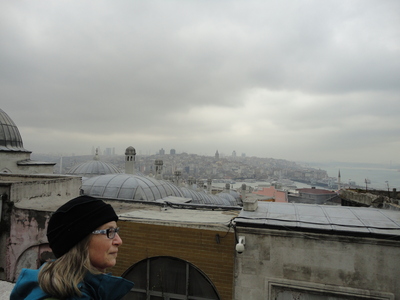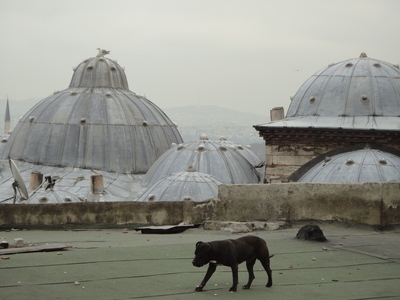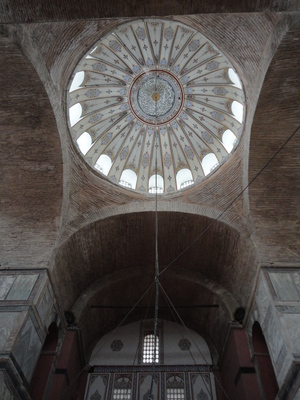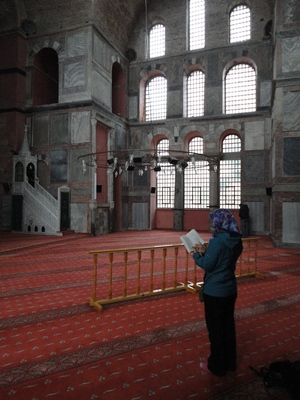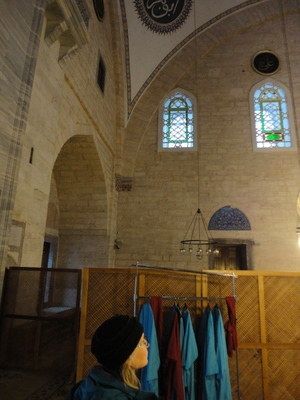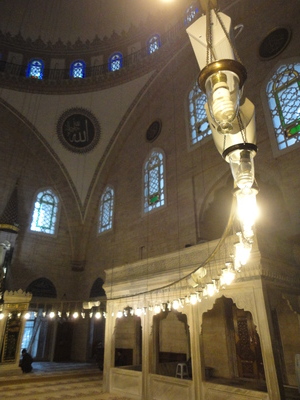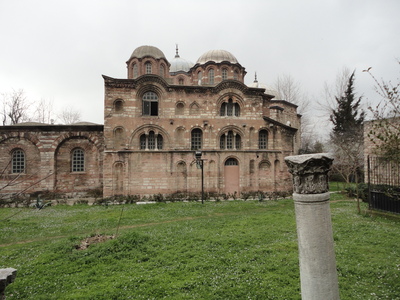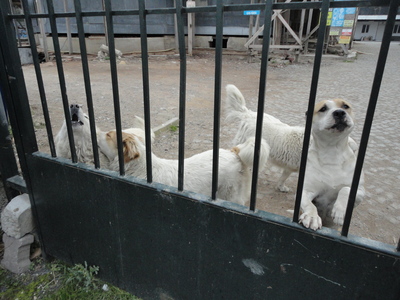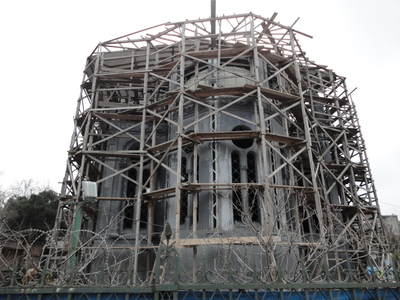Çarşamba
This is about a two-day Istanbul excursion, on Tuesday, March 10, and Sunday, March 15, 2015. The sites discussed below were visited. The sites are mostly either
- Byzantine (from before the Ottoman Turkish conquest of Constantinople in 1453) or else
- built by Mimar Sinan (Sinan the Architect, namesake of my current university) in the sixteenth century.
In order of visitation, the sites are as follows.
- Süleymaniye Mosque, by Sinan.
- The Aqueduct of Valens.
- Kalenderhane Mosque, formerly a church now identified as the Church of the Theotokos Kyriotissa.
- Eski İmaret Mosque, “identified with virtual certainty” as the former Church of the Holy Savior Pantepoptes.
- The Cistern of Aspar.
- The Mosque of Sultan Selim I (father of Süleyman).
- Fethiye Museum, consisting of the parecclesion of the former Church of the Theotokos Pammakaristos; the rest of this church is now the Fethiye Mosque.
- The Church of St Stephen of the Bulgars.
- Hirâmî Ahmed Paşa Mosque, formerly a church thought to be the Church of St John the Baptist in Trullo.
- Mehmed Ağa Mosque, built by Davut Ağa, assistant and successor of Sinan.
- Tercüman Yunus (or Drağman) Mosque, by Sinan.
- Kefevi (or Kefeveli, or Kefeli) Mosque, a Byzantine-era building that may have been the refectory of the Monastery of the Prodromos in Petra.
- Kasım Ağa Mosque, formerly a Byzantine church of unknown name.
- The Cistern of Aetius.
- Chora Museum, formerly Kariye Mosque, formerly the Church of the Holy Savior in Chora.
- Mihrimah Sultan Mosque, by Sinan.
- The land walls of the city of Constantinople, through which the armies of Sultan Mehmet the Conqueror penetrated on Tuesday morning, May 29, 1453.
- The tomb of Abu Ayyub al-Ansari (in Turkish, Eyüp), on the Golden Horn, outside the walls.
The visit to these sites complemented, for me, some earlier excursions, especially one made on Saturday, March 2, 2013. As on that excursion, so now, I benefited from two books:
- Hilary Sumner-Boyd and John Freely. Strolling Through Istanbul (revised and updated). London and New York: Tauris Parke Paperbacks, 2010. First published by Redhouse Press [Istanbul] in 1972.
- Reha Günay. A Guide to the Works of Sinan the Architect in Istanbul. Istanbul: YEM Yayın, July, 2006.
This time there was also one more book:
- Chora Museum: Official Museum Guide. [Istanbul:] BGK (Bilkent Kültür Girişimi), April, 2013.
I did not prepare for the more recent trip by reading my account of the earlier one. Perhaps I should have, so as to be reminded of:
- the story of Aspar (namesake of the cistern) from Gibbon's Decline and Fall of the Roman Empire;
- the image of a sexless Jesus in the Church of the Theotokos Pammakaristos.
Instead I spent my preparation time mainly reading the Chora Museum guide. I had bought this book after a visit to the museum in January, 2014, though I had not then spent much time with the book. It turns out to be excellent, with fine photographs of the individual mosaics and frescoes in the museum, along with a few more panoramic photographs, and extensive accounts of the stories told in the images. The English is good, which is unfortunately not always the case for books of this kind. Translation and editing are credited to Michael D. Sheridan; elsewhere on the colophon, a list of nine authors is given, all with Turkish names; two of these authors—A. Halûk Dursun and Halil Arça—are also listed separately as composing the Editorial Board.
I describe Chora as a museum in the strict sense: this is its current legal status. It used to be a church; then it was made into a mosque; now it has no religious status. But it has been made to appear as if it were the church it once was. Its mosaics and frescoes are in situ.
The occasion of the recent excursion was the visit to Istanbul of my friend Laura, in the company of her friend Julie. In the acknowledgments of my 1997 doctoral dissertation, I credit Laura with having assembled the six-person group-house where (except for a few weeks visiting my future spouse in Manchester, England) I actually wrote the dissertation. The house was in the Mount Pleasant neighborhood of Washington, DC, where there were a number of group-houses; ours seemed exceptional for the shared food and meals. As somebody from another house once observed about us, our refrigerator did not hold six different bottles of ketchup, belonging separately to the members of the household. Actually, we may not even have possessed one bottle of ketchup between us, since we avoided processed foods. We ate common dinners, cooked by one person in rotation, five nights a week. We were a congenial bunch, and I credit Laura in particular for this: she had lived in the house earlier, but then everybody else moved out, and she assembled our group. (She did not do this single-handedly throughout though. I remember being called back for a second interview with all of the earlier-chosen; also a few people left and were replaced by consensual agreement while I lived there.) We had more bicycles than residents, and at most one person ever had a car. As far as I know, the house continues today as a group-house, with the same bicycle-rack constructed when I lived there.
Tuesday
Süleymaniye
On Tuesday morning, March 10, 2015, I met Laura at the Conrad Hotel in Beşiktaş, and we walked along the Bosphorus (as I had done the previous Saturday). We continued across the Galata Bridge, and ultimately up to the Süleymaniye mosque complex. Inside the mosque itself, Laura asked me: if women must cover their hair, why did I not have to cover my own long hair?
I was not generally concerned with documenting our excursion photographically. The point was to enjoy the moment. Also I have photos elsewhere of some of the places we visited. I did however record the view from the garden of the Süleymaniye, as well as the dog that had got onto a nearby roof.
We had lunch at a wonderful place for doing so: the Ali Baba Kanaat Lokantası, just outside the wall of the Süleymaniye garden, in a car-free square paved with marble. One can sit outside, which is what we did, along with many other people, though the day was overcast and cool. The wall of Istanbul University is also adjacent to the square, and university staff eat at the Ali Baba restaurant. Indeed, it appears that this restaurant is the way that some university staff become acquainted with the Süleymaniye Mosque in the first place. A friend of ours from the university observed to my spouse that there was a nice mosque nearby. He was talking about the greatest mosque in Turkey (unless that would the Sultan Ahmet Mosque, near the Hagia Sophia: it seems strange, but I think I have not been in the Sultan Ahmet Mosque since the twentieth century).
The Ali Baba restaurant bills itself as meşhur kurufasülyeci, “famous purveyor of [cooked] dried beans.” This is a humble food; but the word kanaat in the name of the lokanta may allude to this humility. In any case, beans are what I ordered for myself (along with rice and cacık). Our waiter did not speak English, but when I asked about a menu, though he allowed that there was one, he preferred just to say out loud what was available. Laura followed him inside and chose the dish of meat that he recommended. (Our old group-house was vegetarian, but that was twenty years ago.)
Aqueduct of Valens
After lunch, we walked through an archway of the Aqueduct of Valens—that is, we made our way through, like other pedestrians, when a car was not squeezing out everybody. We had taken the left fork in the road; the right fork, through another archway, would have been slightly more efficient.
Kalenderhane Mosque
We reached the Kalenderhane Mosque. I call it a mosque because, again, this is its current legal status. Sheets of multicolored stones line the interior walls, as they have since Byzantine times (though for all I know, they were once painted over). As usual with these former churches, since the architectural orientation is not towards Mecca, the lines in the carpet that indicate the qibla (by being perpendicular to it) are oblique to the walls. Somehow this does not make the building any less acceptable as a Muslim house of worship. I find this reassuring in a day when nominal coreligionists of the Turks—be they Taliban, or the House of Saud, or Daesh (the so-called Islamic State)—are bent on destroying everything that is old, except perhaps for the Kaaba itself (and then why not that too?).
The book called Turkey's Religious Sites (2nd edition) by Anna Edmonds (Istanbul: Damko Publications, 1998) begins with statements (dated in September, 1997) from the Religious Affairs Ministry, the Armenian Patriarchate, the Greek Patriarchate, and the Chief Rabbi, all of Turkey. The middle paragraph of the first of these four statements (credited to Mehmet Nuri Yılmaz, Head of Religious Affairs Administration) reads as follows.
Religious feeling is a natural human impulse. People express their beliefs and their religious feelings by way of their worship. The places of worship are the places where beliefs and worship are performed freely and without stress. Protecting their temples is as important as building them. In this regard the Holy Koran says, “The monasteries, churches, synagogues and mosques where the name of God is often invoked and recited must be protected and not destroyed.” (Hac 22:40). Therefore in observance of this, the places of worship for people of differing faiths in Anatolia are open, often next to each other.
This is rhetoric, not always lived up to. The quotation from the Quran is selective, but may represent a fair interpretation of a longer passage, which is printed as a unit in Muhammad Asad's annotated translation, The Message of the Qur’an (Gibraltar: Dar Al-Andalus, 1984). Here, in Asad's version, are verses 39–41 of the 22nd or Pilgrimage surah—in Arabic Al-Hajj, or in Turkish Hac (I omit Asad's notes):
(39) Permission [to fight] is given to those against whom war is being wrongfully waged—and, verily, God has indeed the power to succour them—: (40) those who have been driven from their homelands against all right for no other reason than their saying, “Our Sustainer is God!”
For, if God had not enabled people to defend themselves against one another, [all] monasteries and churches and synagogues and mosques—in [all of] which God's name is abundantly extolled—would surely have been destroyed [ere now].
And God will most certainly succour him who succours His cause: for, verily, God is most powerful, almighty, (41) [well aware of] those who, [even] if We firmly establish them on earth, remain constant in prayer, and give in charity, and enjoin the doing of what is right and forbid the doing of what is wrong; but with God rests the final outcome of all events.
The point would seem to be that Muslims have a right to defend themselves, just as people of other faiths do—and the evidence of this right is the very existence of the houses of worship of those faiths. God is literally telling the Muslims merely that they may protect themselves; but implicitly, this is only what Christians and Jews have already done, and righteously so, for their religious edifices are also houses of the one God.
Eski İmaret Mosque
I said that the rhetoric of the Ministry of Religious Affairs was not always lived up to. An example might be the Zeyrek Mosque, the former Church of the Pantocrator. It was being restored—or perhaps only renovated, since actual Byzantine scholars had been kicked off the restoration project. The political authorities may have feared lest the scholars find reason to turn the mosque into a museum for all people. On our excursion though, I was confused about the streets that went to the mosque. We ended up just going to the Eski İmaret (“Old Soup Kitchen”) Mosque. When I had first visited this mosque, it was locked. Now it was open, but the afternoon prayer was in progress, and I did not want to intrude.
Cistern of Aspar
We continued on, making our way past the old Darüşşafaka High School building, which is now covered by a great protective canopy, held up by scaffolding. It must be this canopy that I have spied from a distance. We walked past the Cistern of Aspar, remarkable now just for being a great pit that was dug out a millenium and a half ago. I am still sorry not to have seen the days (in living memory) when there was just a village and gardens at the bottom of the cistern.
Mosque of Selim I
We entered the precincts of the Mosque of Selim I, the Grim. Everything is beautiful there: the garden, the view over the Golden Horn, the spare interior of the mosque itself. But the boys in white skullcaps, who study the Quran, make me wonder if there would not be a better use of their time. For I do not suppose that critical thinking is encouraged. My general attitude is Protestant: it is for people to interpret scripture for themselves. On the other hand, it seems Daesh might be counted as Protestant, in one sense: In defiance of global Muslim opinion and the tradition of Islamic teaching, they have decided that they alone are the righteous Muslims. If the boys at the Mosque of Selim are being taught a bunch of silly rules for how to live their own lives, like which foot to use when entering or exiting a bathroom, this may be better than giving their allegiance to Abu Bakr al-Baghdadi, because of an interpretation of Islamic history that naive students can be taught to make, seemingly for themselves.
Fethiye Museum
We moved on to the heart of the district of Çarşamba, where many women wear the niqab, and many men sport long dark robes and bushy beards. There was a congregation of these men, sporting white turbans as well, hanging out near the İsmail Ağa Mosque. Laura and I entered a halal grocery store: it seemed the best place to buy water. People inside seemed friendly, though apparently the cashier wanted Laura to put her coin onto the counter, not directly into his hand.
In the Munich airport, Ayşe and I once met a rabbi with whom we had a pleasant chat. His job was to give kosher certification to food products. I noted that the brand of Turkish olive oil that I often bought had this certification. When we parted, the man apologized to Ayşe for not being able to shake her hand. I suppose the man in the halal shop would refuse a woman's hand.
Somebody might argue that by carefully distinguishing the sexes, one keeps sexual acts themselves exciting. I shall suggest then that this excitement is not itself desirable. I do not necessarily agree with the idea that there are just two sexes anyway.
I could possibly be arguing against Albert Einstein here, of whom Raymond Smullyan says:
There is another story that Einstein once told a colleague that he did not like teaching at a co-ed college because with all the pretty girls in the room, the boys wouldn't pay enough attention to mathematics and physics. His friends said, “Oh come on now Albert, you know the boys would listen to what you have to say.” Einstein replied, “Oh, such boys are not worth teaching.”
This is “puzzle” number 215 of What is the Name of This Book?—The Riddle of Dracula and Other Logical Puzzles (Englewood Cliffs, New Jersey: Prentice-Hall, 1978). There may be a case for single-sex education. I am the product of nine years of it (though with some shared classes with a sister school in the later years). But did Einstein not think that girls were worth teaching? Perhaps he did at that: for Smullyan's “puzzle” number 214 is as follows.
There is an allegedly true story about a little girl living in Princeton, New Jersey, who was having trouble with her arithmetic. In a period of about two months she, for some unknown reason, made a startling improvement. One day her mother asked her if she knew the reason for her improvement. The little girl replied: “I heard there is a professor in this town who's good at numbers. I rang his doorbell, and every day he's been helping me. He teaches real good.” The mother, somewhat startled, asked her whether she knew his name. The little girl replied, “Not exactly; it goes something like Ein-stein.”
That's real free-range parenting, if a mother doesn't realize her little girl has been visiting a strange man for two months! This may be enough reason to suspect the veracity of the story.
Çarşamba is a Persian borrowing, analyzable into parts that are cognate with the English “fourth Sabbath”: and the meaning of the word is indeed the fourth day after the Jewish day of rest, or Wednesday. Apparently the bazaar day for the Çarşamba district is Wednesday. However, the Turkish pazar means both bazaar and the usual bazaar day, which is Sunday. In any case, on Tuesday in Çarşamba, Laura and I walked to the gate of the Fethiye Museum, but we were too late: it was closed for the day. The southern face of this former church could still be admired from the outside.
Church of St Stephen of the Bulgars
We descended to the Golden Horn and walked along this. We paused at the Church of St Stephen of the Bulgars, now under thorough renovation, and guarded by dogs eager to do their duty.
This is the cast-iron church, “prefabricated in Vienna and shipped down the Danube in sections,” according to Sumner-Boyd and Freely: it was “erected in 1871, at a time when the Bulgarian Church was asserting its independence from the Greek Orthodox Patriarchate of Constantinople.” According to the Wikipedia article (probably written by somebody who knows), a firman establishing a Bulgarian Exarchate was read in a wooden church on the site in 1870; but the iron church itself was produced in Vienna in 1893–6, and erection in Istanbul was completed in 1898.
This last date is confirmed in Murat Gül and Trevor Howard, Istanbul Architecture (Boorowa, NSW, Australia: The Watermark Press, 2013). According to this book, the architect Hovsep Aznavour chose to use iron for the church because the waterside site would not have supported the weight of masonry. The book notes that the church itself is oriented not due east, but directly towards the water.
We entered the Metro at the Haliç (that is, Golden Horn) station, which sits right in the middle of the bridge over the indicated estuary. We took the Metro to Gayrettepe station, which is a dystopia of highways overhead and pedestrian tunnels underground. We did manage to make our way to Beşiktaş, but it took longer than expected, and possibly I had not chosen the best tunnels. We met Julie and had dinner outdoors at Ahtapot, by the fish market in Beşiktaş. (Meanwhile, Ayşe was flying back from Ankara.)
